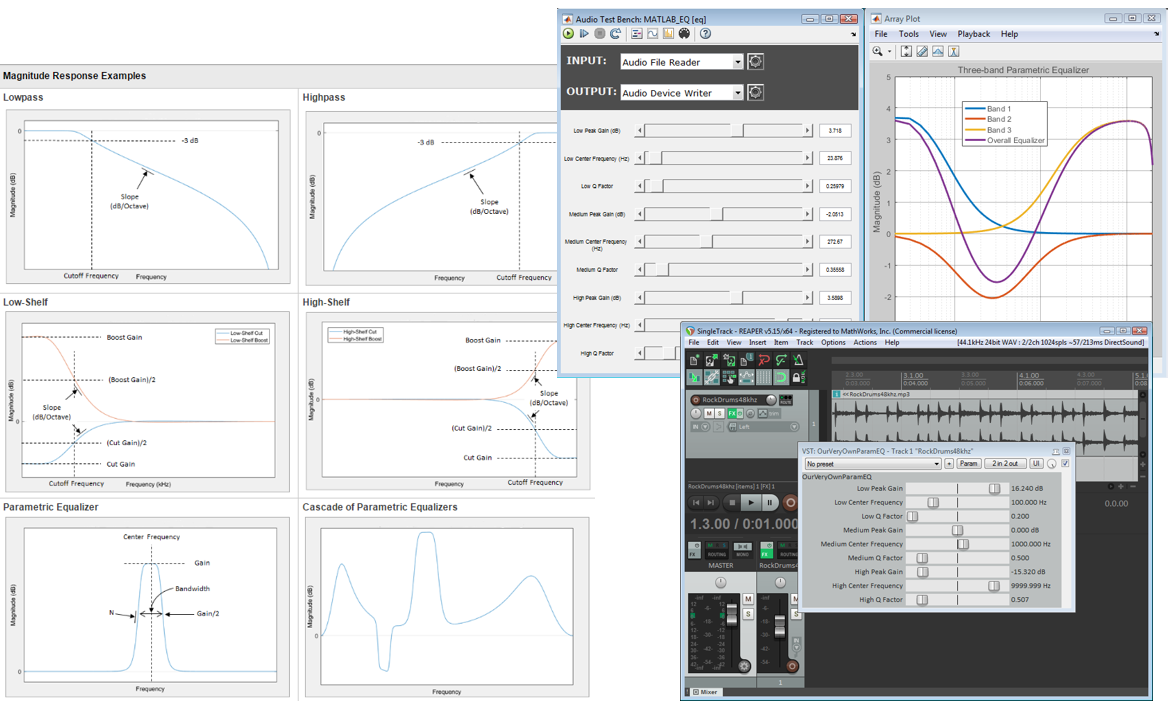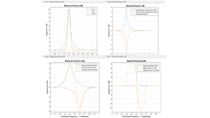Design and analyze a parametric EQ audio filter
A parametric equalizer (parametric EQ, or EQ) is one of the specialized filters provided by Audio Toolbox™ for audio signal processing. It is typically a cascade of independently tunable filters used to alter the spectrum response characteristics of the original sound by cutting (gain attenuation) or boosting (gain increase) specific frequency bands in real time with MATLAB® and Simulink®.
In practice, several parametric equalizers are cascaded and used simultaneously to equalize an audio signal. A parametric equalizer is one of the widely used audio filters in audio systems and audio plugin in digital audio workstations (DAWs) for altering, blending, or correcting sound or music.
For example, the parametric equalizer:
- Enhances the listening experience by finely adjusting specific frequency bands to improve a particular musical instrument sound coming out of smartphone or MP3 player headphones, home stereo speakers, or car stereos
- Enables control of multiple key filter parameters individually to alter the overall frequency response characteristics of multichannel streaming audio
- Provides control for peak gain, central frequency, and bandwidth (quality factor) over a wide range of frequencies
Audio Toolbox and DSP System Toolbox provide many algorithms and specialized filter design techniques to quickly design, implement, and analyze tunable multiband parametric equalizers in MATLAB or Simulink. Depending on the audio filter constraints, you can design second-order or high-order IIR filters, which provide much more control over the shape of the filter by yielding sharper transition bands for the same bandwidth gain. For the design process, you can use various criteria ranging from quality factor to octave bandwidth constraints, using many filter types including low shelving and high shelving filters, and peaking and notching filters.
If you design an equalizer or another audio processing algorithm using MATLAB, you can use Audio Toolbox to convert it into a VST plugin to run it natively in an external DAW. Alternatively, if you already own an equalization algorithm as a VST plugin, you can host it in MATLAB and control it programmatically like a regular object to process MATLAB arrays.
Left: Examples of magnitude responses commonly used for signal equalization. Top right: A custom implementation of a three-band parametric equalizer tested in real time using the Audio Test Bench app. Bottom right: A VST plugin generated from a MATLAB authored parametric equalizer, as seen from REAPER, a third-party DAW.
Examples and How To
- Parametric Equalizer Design (Example)
- Generate Standalone Executable for Parametric Audio Equalizer (Example)
- Multiband Dynamic Range Compression (Example)
- Tunable Lowpass Filtering of Audio Input in Simulink (Example)
- Parametric Audio Equalizer for ARM Cortex-M Processor (Example)
- Real-time Audio Processing for Algorithm Prototyping and Custom Measurements (45:08) (Webinar)
Software Reference
- Multiband Parametric Equalizer in MATLAB (Documentation)
- Convert MATLAB Code to an Audio Plugin (Documentation)
- Host External Audio Plugins (Documentation)
- Audio Plugin Example Gallery (Documentation)
- Filterbuilder App (Documentation)
- Parametric Equalizer in Simulink (Documentation)
- Second-Order Tunable Notching and Peaking IIR Filter in MATLAB (Documentation)
- Variable Bandwidth IIR Filter in MATLAB (Documentation)
- Record Audio Data Using Computer's Audio Device in MATLAB (Documentation)
- From Audio Device in Simulink (Documentation)
See also: Audio Toolbox, DSP System Toolbox, Communications Toolbox, LTE Toolbox, Phased Array System Toolbox, Signal Processing Toolbox, HDL Coder, Embedded Coder, Simulink Coder, Fixed-Point Designer, RF Blockset, RF Toolbox, stream processing in MATLAB, logic analyzer, spectrum analyzer software, audio signal processing, oscilloscope software, channel model


